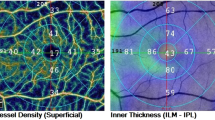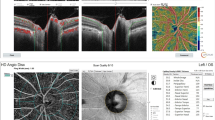Abstract
Purpose
Optical coherence tomography angiography (OCTA) is an increasingly widespread imaging tool that allows the visualization of the microvascular structures of the eye. It should be kept in mind in clinical practice, Valsalva maneuver (VM) may have an effect on OCTA findings. We aimed to evaluate the effect of VM on the optic nerve and retinal blood flow parameters measured by OCTA.
Methods
Sixty age- and sex-matched healthy volunteers were included into this prospective study. Optic disc status for radial peripapillary capillary (RPC) network [whole image, inside disc and peripapillary capillary densities], superficial and deep capillary plexus whole, foveal, parafoveal and perifoveal densities and foveal avascular zone (FAZ) densities of volunteers were examined by OCTA both at rest and during VM.
Results
The mean age of the subjects was 31.48 ± 7.49 (18–50) years and 51.7% were male. Superficial whole, parafoveal and perifoveal vessel densities were found to be significantly decreased during VM (p = 0.008, p= 0.015, p = 0.017, respectively). Lower levels of deep whole, parafoveal and perifoveal vessel densities were also detected while VM (p < 0.001 for all). However, there were no significant differences in terms of foveal vessel and FAZ densities. Additionally, VM significantly decreased RPC densities for whole image, inside and peripapillary capillary (p = 0.005, p < 0.001, p = 0.039, respectively).
Conclusion
VM may cause a significant decrease in optic nerve and para-perifoveal blood flow. Therefore, patient instruction about not holding breath is required before OCTA scanning.


Similar content being viewed by others
References
Zong Y, Xu H, Yu J et al (2017) Retinal vascular autoregulation during phase IV of the Valsalva maneuver: an optical coherence tomography angiography study in healthy Chinese adults. Front Physiol 8:553
Abidi S, Nili M, Serna S et al (2017) Influence of sex, menstrual cycle, and oral contraceptives on cerebrovascular resistance and cardiorespiratory function during Valsalva or standing. J Appl Physiol 123:375–386
Kim YH, Phillips VZ, Paik S et al (2018) Prefrontal hemodynamic changes measured using near-infrared spectroscopy during the Valsalva maneuver in patients with orthostatic intolerance. Neurophotonics 5:015002
Holló G (2018) Valsalva maneuver and peripapillary OCT angiography vessel density. J Glaucoma 27:133–136
Chan G, Balaratnasingam C, Paula KY et al (2012) Quantitative morphometry of perifoveal capillary networks in the human retina. Investig Ophthalmol Vis Sci 53:5502–5514
Tan PEZ, Paula KY, Balaratnasingam C et al (2012) Quantitative confocal imaging of the retinal microvasculature in the human retina. Investig Ophthalmol Vis Sci 53:5728–5736
Lim CW, Cheng J, Tay ELT et al (2018) Optical coherence tomography angiography of the macula and optic nerve head: microvascular density and test–retest repeatability in normal subjects. BMC Ophthalmol 18:315
She X, Guo J, Liu X et al (2018) Reliability of vessel density measurements in the peripapillary retina and correlation with retinal nerve fiber layer thickness in healthy subjects using optical coherence tomography angiography. Ophthalmologica 240:183–190
Pappelis K, Jansonius NM (2019) Quantification and repeatability of vessel density and flux as assessed by optical coherence tomography angiography. Transl Vis Sci Technol 8:3
Hassan M, Sadiq MA, Halim MS et al (2017) Evaluation of macular and peripapillary vessel flow density in eyes with no known pathology using optical coherence tomography angiography. Int J Retina Vitr 3:27
Samara WA, Say EA, Khoo CT et al (2015) Correlation of foveal avascular zone size with foveal morphology in normal eyes using optical coherence tomography angiography. Retina 35:2188–2195
Magrath GN, Say EAT, Sioufi K et al (2017) Variability in foveal avascular zone and capillary density using optical coherence tomography angiography machines in healthy eyes. Retina 37:2102–2111
Hayreh SS (2001) Blood flow in the optic nerve head and factors that may influence it. Prog Retin Eye Res 20:595–624
Kim YW, Lee DH, Lim HB et al (2019) Age-dependent variation of lamina cribrosa displacement during the standardized Maneuver. Sci Rep 9:6645
Li X, Wang W, Chen S et al (2016) Effects of Valsalva maneuver on anterior chamber parameters and choroidal thickness in healthy Chinese: an AS-OCT and SS-OCT study. Investig Ophthalmol Vis Sci 57:189–195
Li F, Gao K, Li X et al (2017) Anterior but not posterior choroid changed before and during Valsalva manoeuvre in healthy Chinese: a UBM and SS-OCT study. Br J Ophthalmol 101:1714–1719
Kinoshita T, Mori Junya, Okuda N et al (2016) Effects of exercise on the structure and circulation of choroid in normal eyes. PLoS ONE 11:e0168336
Stodtmeister R, Heyde M, Georgii S et al (2018) Retinal venous pressure is higher than the airway pressure and the intraocular pressure during the Valsalva manoeuvre. Acta Ophthalmol 96:e68–e73
Mete A, Kimyon S, Saygılı O et al (2016) Dynamic changes in optic disc morphology, choroidal thickness, anterior chamber parameters, and intraocular pressure during Valsalva maneuver. Arq Bras Oftalmol 79:209–213
Fernández MG, Navarro JC, Castaño GC (2012) Long-term evolution of Valsalva retinopathy: a case. J Med Case Rep 6:346
Funding
No funding.
Author information
Authors and Affiliations
Corresponding author
Ethics declarations
Conflict of interest
The authors declare that they have no conflict of interest.
Ethical approval
All procedures performed in studies involving human participants were in accordance with the ethical standards of the institutional and/or national research committee and with the 1964 Helsinki Declaration and its later amendments or comparable ethical standards (Mustafa Kemal University Ethics Committee approval).
Informed consent
Informed consent was obtained from all individual participants included in the study.
Additional information
Publisher's Note
Springer Nature remains neutral with regard to jurisdictional claims in published maps and institutional affiliations.
Rights and permissions
About this article
Cite this article
Ozcan, S.C., Kurtul, B.E. & Ozarslan Ozcan, D. Evaluation of microvascular changes in optic disc and retina by optical coherence tomography angiography during Valsalva maneuver. Int Ophthalmol 40, 2743–2749 (2020). https://doi.org/10.1007/s10792-020-01461-x
Received:
Accepted:
Published:
Issue Date:
DOI: https://doi.org/10.1007/s10792-020-01461-x




